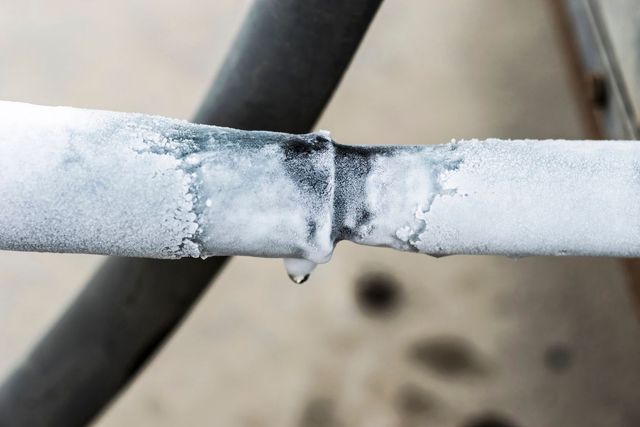We have unearthed this post relating to What Do I Do If My AC Pipe Is Frozen directly below on the web and believe it made perfect sense to write about it with you on my blog.

Introduction
Finding that your air conditioner pipe is frozen can be concerning, particularly throughout warm summer season when you rely upon your ac system one of the most. Comprehending what to do in such a situation is critical to prevent further damage to your air conditioning system and guarantee your comfort indoors.
Comprehending the Causes
Numerous aspects can contribute to the cold of an air conditioner pipeline. Comprehending these causes can aid you attend to the problem successfully.
Absence of Airflow
One common reason for an icy air conditioner pipeline is inadequate airflow. When the air movement over the evaporator coil is limited, it can cause the coil to drop below freezing temperature level, bring about ice development on the pipeline.
Low Refrigerant Levels
Inadequate refrigerant levels in your air conditioner system can additionally result in a frozen pipe. Low cooling agent levels can create the pressure in the system to drop, bring about the cold of dampness on the evaporator coil.
Winter Conditions
In colder climates, freezing temperatures outside can add to the cold of air conditioning pipelines. If your a/c device is not effectively protected or if there are leaks in the ductwork, cold air can penetrate the system, triggering the pipe to ice up.
Dirty Air Filters
Dirty or clogged up air filters can restrict air movement in your air conditioner system, resulting in different issues, consisting of an icy pipeline. It's necessary to replace or clean your air filterings system regularly to make sure appropriate air flow and prevent ice buildup.
Indications of a Frozen Air Conditioning Pipe
Identifying the indicators of an icy a/c pipe is important for prompt action.
Reduced Airflow
If you discover a considerable decrease in air flow from your vents, it can indicate an icy pipe.
Ice Buildup on the Pipe
Visible ice accumulation on the refrigerant line or the evaporator coil is a clear indicator of a frozen a/c pipe.
Strange Sounds from the Unit
Unusual sounds, such as hissing or gurgling, coming from your AC system can signal that there's ice present on the pipe.
Immediate Actions to Take
When faced with a frozen AC pipe, it's essential to act rapidly to stop further damages to your air conditioning system.
Turning off the air conditioner
The very first step is to shut off your air conditioner to stop the system from running and intensifying the concern.
Looking for Blockages
Inspect the area around the indoor unit for any obstructions that might be obstructing air movement, such as furniture or drapes.
Thawing the Pipe
You can utilize gentle methods like positioning towels taken in cozy water around the frozen pipe to aid thaw it slowly.
Preventive Measures
Taking preventive measures can aid prevent future events of an icy air conditioning pipeline.
When DIY Methods Fail
If your attempts to thaw the pipe or address various other problems are unsuccessful, it's time to contact an expert.
Significance of Hiring a Professional HVAC Technician
A licensed HVAC service technician has the experience and devices essential to diagnose and repair problems with your a/c system safely and successfully.
Normal Maintenance Checks
Schedule regular upkeep get in touch with a specialist HVAC service technician to guarantee that your air conditioner system is running effectively.
Transforming Air Filters
Frequently change or clean your air filters to avoid air movement restrictions and preserve optimum performance.
Protecting Exposed Pipes
If your air conditioning pipelines are exposed to cool temperature levels, consider insulating them to stop freezing during winter months.
Seeking Professional Help
If DIY methods fail to resolve the concern or if you're unsure concerning how to continue, it's finest to seek support from a qualified HVAC specialist.
Conclusion
Handling an icy air conditioner pipe can be a frustrating experience, however knowing exactly how to react can help decrease damage and bring back convenience to your home. By recognizing the reasons, recognizing the indications, and taking punctual action, you can successfully resolve the issue and avoid future events.
What to Do If Your AC Line Is Frozen
Make Sure All Supply and Return Air Vents Are Open
If you notice problems with airflow, the first thing you should do is check your supply and return vents. Supply vents distribute clean, conditioned air throughout your home. As this air becomes stale, it’s pulled into the return vent, where it’s reconditioned before being sent back out through the supply vent.
When these vents are closed, air won’t flow in the home. Before examining your AC, check the vents in every room and ensure they’re all open.
Check for a Dirty Air Filter
Another possible cause of limited airflow is a dirty air filter. Your air conditioner’s filters catch elements you don’t want to breathe in, such as dirt and dust. Over time, filters can become clogged, ultimately blocking air from flowing in and out. The lack of airflow can then cause the entire coil to freeze and will completely restrict any air from moving through it. The AC may need to be powered off for one to two days to allow the coil to thaw after replacing the filter to allow proper functioning of the unit. This debris can also accumulate on your AC’s evaporator coil, requiring a more serious repair. In general, air filters should be cleaned regularly (about every two weeks).
Assess Your Outdoor Unit
In addition to checking your AC, assessing the outdoor unit is a good idea. Also known as the condensing unit, it works with your interior unit to release heat outside. An issue with the outdoor unit can result in rising internal temperatures.
Overgrown Shrubs or Clogged Leaves
From leaves and twigs to shrubs and debris, there’s no shortage of outdoor elements that can accumulate around your condensing unit. When these elements get lodged inside the unit, they can block airflow. Fortunately, removing the blockage can solve the problem.
Sounds of a Broken Fan
Shrubs and leaves aren’t the only things that can impede your outdoor unit’s airflow. If the fan is broken, the unit won’t be able to properly get rid of heat — which means the internal temperature won’t go down. First, make sure the fan is spinning. If it is, check for the following sounds of a broken fan:
Buzzing Rattling Screeching Hissing Clicking Preventative Measures
Nobody wants to deal with a frozen AC line. In addition to causing problems with your air conditioner, they require professional repairs. On the bright side, there are preventative measures you can take to help ensure this issue doesn’t arise in the first place.
https://www.coopergreenteam.com/blog/what-to-do-if-ac-line-frozen

I am very fascinated with Have a Frozen AC Line? Here’s How to Fix It and I am hoping you enjoyed reading the new page. Sharing is caring. Helping others is fun. Thank you for your time. Visit again soon.
Schedule Service